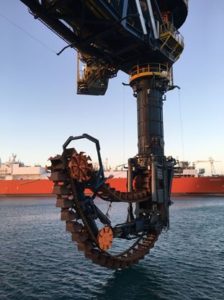Successful delivery of a Continuous Ship Unloader


Source: TAKRAF
Global mining, bulk material handling and minerals processing solutions provider, Tenova TAKRAF recently completed the delivery of a Continuous Ship Unloader (CSU) to handle iron ore at the Port of Pecem, Brazil. The major turnkey contract was awarded by Secretaria Da Infraestrutura (SEINFRA) – Governo Do Estado Do Ceara in March 2014.
The CSU has a nominal capacity of 2,400 t/h and is able to unload vessels up to 125,000 DWT.
The CSU is equipped with a bucket-chain elevator approximately 35 m in height and with a slewing/lifting boom, which includes the transfer conveyor, for a total length of 42 m. The discharge on the conveyor jetty is via a vibrating feeder, a solution that has already proven highly successful on other machines, and which offers a number of advantages. Some of these advantages include being more compact and hence reducing the height of the machine; an important factor to consider given that the jetty conveyors are more elevated than usual.
The entire project was successfully concluded thanks to the collaborative effort and synergies between the various TAKRAF offices: design and construction of the CSU was carried out in Italy; TAKRAF’s China office was fully engaged and oversaw all matters related to complete manufacturing and assembly of the machine, whilst the company’s Brazil office was responsible for all local project activities up to commissioning.
This major contract award was TAKRAF’s first from SEINFRA and was won as a result of a number of important factors having been considered in the final decision. Since the CSU was to be installed in an area close to the city, the client placed specific emphasis upon limiting environmental impact and selected TAKRAF’s machine for its various environmentally friendly solutions. One of these solutions relates to the fact that the material flow is totally enclosed with the “digging foot” operating within the ship’s hold and discharging material through transfer chutes, maximizing dust suppression and noise reduction.
TAKRAF developed the bucket-chain CSU in the 1980s and has subsequently supplied more than 15 machines to date worldwide with a variety of technological improvements having been applied to each new machine. The most sophisticated part of the machine is the articulated-type “digging foot” for which TAKRAF Italy owns the patent. Through the coordinated movement of dedicated hydraulic cylinders, the “digging foot” can modify its geometrical configuration to obtain optimal bucket filling and to reach the walls of the ship’s hatches to remove residual material. Recent contract awards for bucket-chain CSUs from, for example, ENEL (the main Italian power station in Brindisi and Civitavecchia) and ILVA (Taranto Iron & Steel Works, also in Italy), once again highlight the excellent performance that is achieved through this technology.
Once the manufacturing and assembly process was concluded, the CSU (machine body and elevator) was moved inside the Tianjin (China) harbor, from a private to a public quay, through a special barge and crane vessel, in order to allow for the mooring of a specialized transport vessel. The greatest challenge facing the project was in fact the transport of the CSU (boasting an approx. weight of 1,800 tons) almost fully erected from China to Brazil. The operation was successfully concluded within the expected transit time of 35 days and the Provisional Acceptance Certificate was released in November 2016. The entire project was successfully concluded thanks to the positive collaboration with SEINFRA and the constant coordination and cooperation between all parties concerned.
